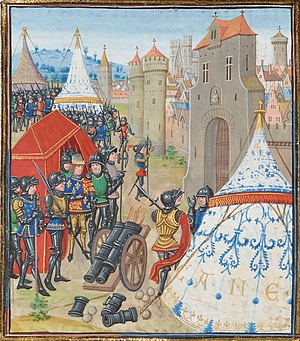| Reims campaign | |||||||
|---|---|---|---|---|---|---|---|
| Part of the Hundred Years' War | |||||||
 Edward III before Reims | |||||||
| |||||||
| Belligerents | |||||||
|
|
| ||||||
| Commanders and leaders | |||||||
|
|
| ||||||
The Reims campaign took place during the Hundred Years' War. It occurred after the French de facto government rejected the terms of the Treaty of London and consequently Edward III of England organised and commanded an expeditionary army to gain by force what he had failed to win by diplomacy. On 28 October 1359 Edward landed at Calais, and advanced to Reims, where he hoped to be crowned king of France. The strenuous resistance of the citizens frustrated this scheme, and Edward marched into Burgundy, and then he made his way back towards Paris. Failing in an attack on the capital, he was glad to conclude, on 8 May 1360, preliminaries of peace at Brétigny, near Chartres. This treaty, less onerous to France than that of London, took its final form when Edward and John ratified the treaty in Calais on 9 October 1360. By it Edward renounced his claim to France in return for Aquitaine and other French territories in full sovereignty.[1]